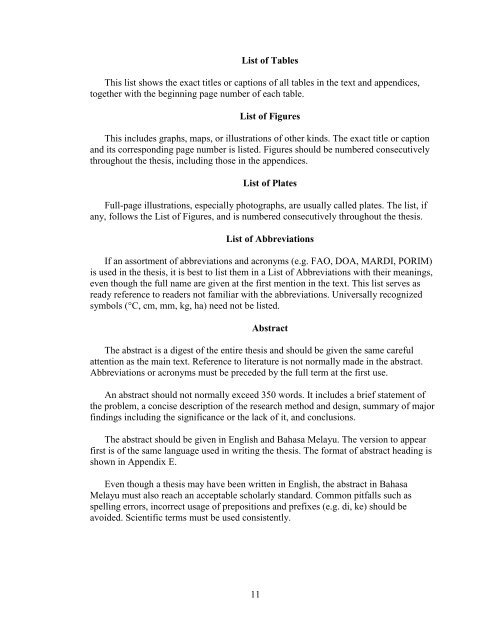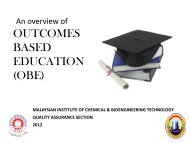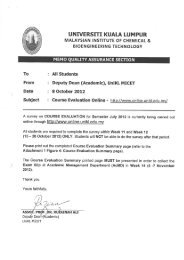guide to the preparation of thesis - UniKL MICET E-learning ...
guide to the preparation of thesis - UniKL MICET E-learning ...
guide to the preparation of thesis - UniKL MICET E-learning ...
You also want an ePaper? Increase the reach of your titles
YUMPU automatically turns print PDFs into web optimized ePapers that Google loves.
List <strong>of</strong> Tables<br />
This list shows <strong>the</strong> exact titles or captions <strong>of</strong> all tables in <strong>the</strong> text and appendices,<br />
<strong>to</strong>ge<strong>the</strong>r with <strong>the</strong> beginning page number <strong>of</strong> each table.<br />
List <strong>of</strong> Figures<br />
This includes graphs, maps, or illustrations <strong>of</strong> o<strong>the</strong>r kinds. The exact title or caption<br />
and its corresponding page number is listed. Figures should be numbered consecutively<br />
throughout <strong>the</strong> <strong>the</strong>sis, including those in <strong>the</strong> appendices.<br />
List <strong>of</strong> Plates<br />
Full-page illustrations, especially pho<strong>to</strong>graphs, are usually called plates. The list, if<br />
any, follows <strong>the</strong> List <strong>of</strong> Figures, and is numbered consecutively throughout <strong>the</strong> <strong>the</strong>sis.<br />
List <strong>of</strong> Abbreviations<br />
If an assortment <strong>of</strong> abbreviations and acronyms (e.g. FAO, DOA, MARDI, PORIM)<br />
is used in <strong>the</strong> <strong>the</strong>sis, it is best <strong>to</strong> list <strong>the</strong>m in a List <strong>of</strong> Abbreviations with <strong>the</strong>ir meanings,<br />
even though <strong>the</strong> full name are given at <strong>the</strong> first mention in <strong>the</strong> text. This list serves as<br />
ready reference <strong>to</strong> readers not familiar with <strong>the</strong> abbreviations. Universally recognized<br />
symbols (°C, cm, mm, kg, ha) need not be listed.<br />
Abstract<br />
The abstract is a digest <strong>of</strong> <strong>the</strong> entire <strong>the</strong>sis and should be given <strong>the</strong> same careful<br />
attention as <strong>the</strong> main text. Reference <strong>to</strong> literature is not normally made in <strong>the</strong> abstract.<br />
Abbreviations or acronyms must be preceded by <strong>the</strong> full term at <strong>the</strong> first use.<br />
An abstract should not normally exceed 350 words. It includes a brief statement <strong>of</strong><br />
<strong>the</strong> problem, a concise description <strong>of</strong> <strong>the</strong> research method and design, summary <strong>of</strong> major<br />
findings including <strong>the</strong> significance or <strong>the</strong> lack <strong>of</strong> it, and conclusions.<br />
The abstract should be given in English and Bahasa Melayu. The version <strong>to</strong> appear<br />
first is <strong>of</strong> <strong>the</strong> same language used in writing <strong>the</strong> <strong>the</strong>sis. The format <strong>of</strong> abstract heading is<br />
shown in Appendix E.<br />
Even though a <strong>the</strong>sis may have been written in English, <strong>the</strong> abstract in Bahasa<br />
Melayu must also reach an acceptable scholarly standard. Common pitfalls such as<br />
spelling errors, incorrect usage <strong>of</strong> prepositions and prefixes (e.g. di, ke) should be<br />
avoided. Scientific terms must be used consistently.<br />
11




